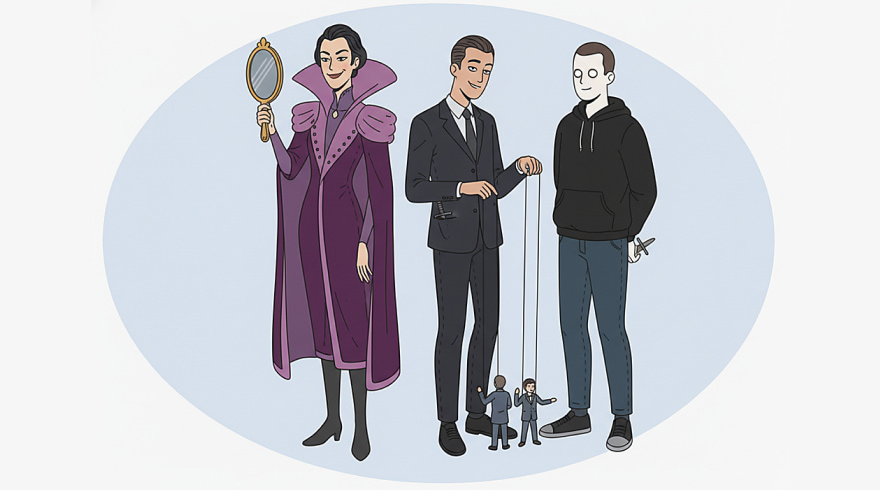Dark Triad of Personality Test: Charisma, Influence, Decisions
- 19 October 2025

What It Means and Why It Captivates Ambitious Minds
High-performance environments reward clarity under pressure, social agility, and unflinching resolve. The cluster of traits often labeled Machiavellianism, narcissism, and psychopathy offers a controversial lens for understanding how certain people thrive in volatile, uncertain, complex, and ambiguous contexts. Rather than moralizing, this guide focuses on how those tendencies manifest, how to identify them in the wild, and how to channel their more adaptive sides toward constructive outcomes without crossing ethical lines.
Many readers are drawn to this terrain because it illuminates competitive dynamics, political games, and the mechanics of power. In that context, a framework called the dark triad of personality has sparked both heated debate and practical curiosity, especially among professionals who operate in high-conflict or winner-take-most fields. Understanding the profile helps distinguish cold calculation from steady leadership, performative confidence from deep expertise, and daring risk-taking from reckless gambles.
Critically, the allure is not about glorifying cruelty; it is about decoding signals. People with these traits can appear magnetic in negotiation rooms, unflappable in crisis, or innovative when others freeze. Each advantage, however, hides mirrored costs: trust erosion, reputational backlash, and burnout. The most effective operators learn to keep the steel, drop the spikes, and build systems that convert sharp edges into disciplined, long-term leverage.
- Calibrate charm into credibility through consistent delivery.
- Transmute ruthless focus into fair, transparent prioritization.
- Replace impulsivity with pre-commitment, checklists, and post-mortems.
Traits, Mechanisms, and Real-world Patterns
Before exploring benefits and boundaries, it helps to dissect the profile into observable behaviors. Machiavellianism centers on strategic manipulation and long-game planning. Narcissism revolves around status hunger, recognition, and self-enhancing narratives. Psychopathy highlights low fear, low empathy, and high sensation seeking. Each trait can tilt toward either destructive outcomes or pragmatic advantages depending on context, incentives, and guardrails.
Assessment models vary, yet they share a focus on self-report items and behavioral indicators. In research and coaching settings, many professionals rely on a calibrated instrument sometimes called a dark triad personality test to benchmark patterns alongside other personality dimensions. Results should never be read in isolation, because context, role demands, and culture determine whether the same behaviors look like bold leadership or raw opportunism.
Spotting the Signals Without Overreacting
- Machiavellianism: tactical charm, coalition building, and contingency planning.
- Narcissism: grand vision, stage presence, and appetite for recognition.
- Psychopathy: cool affect under duress, fast decisions, and risk appetite.
To make the distinctions clearer at a glance, the quick matrix below compares hallmark behaviors, plausible advantages, and common risks when these tendencies run hot. Use it as a heuristic, not a diagnosis.
| Trait | Typical Behaviors | Potential Upsides | Common Risks |
|---|---|---|---|
| Machiavellianism | Strategic persuasion, information control, long-horizon scheming | Negotiation leverage, coalition strategy, crisis navigation | Trust erosion, opaque motives, ethical slippage |
| Narcissism | Vision casting, spotlight seeking, status sensitivity | Brand building, morale boosting, audacious goal setting | Fragile ego, blame shifting, team alienation |
| Psychopathy | Low fear, rapid action, high novelty seeking | Calm under pressure, decisive pivots, emergency leadership | Recklessness, empathy gaps, legal or compliance exposure |
Seen this way, the profile functions like a set of high-voltage tools: extraordinarily powerful when grounded properly, hazardous when used carelessly. The artistry lies in designing systems governance, feedback loops, and constraints that let the advantages shine while neutralizing predictable downsides.
Strategic Benefits and Adaptive Upsides
In competitive arenas, cool risk perception can keep teams moving while others stall. Charisma can mobilize talent and capital around a bold thesis. Strategic detachment can reduce decision noise, allowing leaders to exit sunk-cost traps sooner and negotiate from a position of calm. These attributes, when harnessed conscientiously, become performance multipliers rather than sources of interpersonal damage.
Practical self-knowledge helps you channel strengths without broadcasting liabilities. For early exploration, some readers consider a dark triad personality test free option to develop a preliminary sense of patterns before seeking professional interpretation. Whatever the entry point, the value emerges when results translate into habits: structured pre-briefs, ethical checklists, and accountability partners who can call out overreach in real time.
Turning Edge into Endurance
- Convert charm into repeatable influence by anchoring it in real competence.
- Transform dominance into stewardship through fair rules and open metrics.
- Use fearless decision-making to protect teams, not just personal stakes.
- Pair high ambition with principled constraints and transparent escalation paths.
Organizations can also benefit by assigning pressure-hardy people to crisis response, restructuring, or turnaround projects contexts that demand rapid triage and emotional steadiness. Meanwhile, governance structures, peer reviews, and ethics coaching provide ballast so boldness does not mutate into collateral damage.
Assessment, Scores, and Interpretation Without Myths
No single instrument can capture the full complexity of human behavior, but disciplined assessment can illuminate tendencies worth tracking. Data-minded professionals often mix self-report tools with 360 feedback, behavioral interviews, and performance analytics. The goal is not to label people as saints or villains; it is to map patterns that interact with role demands, incentives, and culture.
Engagement can be more approachable when it feels interactive, which is why an accessible dark triad personality quiz can serve as a conversation starter before a deeper debrief with a qualified practitioner. The most valuable takeaways arise when results prompt concrete experiments, like pre-committing to cooling-off periods before major calls or codifying red-team challenges to counteract overconfidence.
From Numbers to Behavior Change
- Translate scale scores into specific “if-then” rules for high-stakes moments.
- Bundle findings with stress data, sleep metrics, and workload to reveal triggers.
- Repeat assessments after interventions to measure signal, not noise.
Finally, handle privacy and consent with care. Share results on a need-to-know basis, document mitigation plans, and avoid weaponizing assessments in internal politics. Measurement should elevate decision quality, not arm gossip.
Ethics, Boundaries, and Sustainable Success
Power without principles burns reputations and teams. The most durable strategists set non-negotiable boundaries while leveraging cool-headed judgment, persuasive communication, and bold execution. With the right scaffolding, it is possible to keep the advantages clarity in chaos, stamina in conflict, persuasion under scrutiny while shielding colleagues and stakeholders from harm.
If you plan to formalize reflection, structured prompts in a dark triad questionnaire can drive more honest answers when paired with confidentiality and clear intent. Follow-through matters more than labels: leaders earn trust by keeping promises, crediting teams, and owning mistakes while maintaining a sharp competitive edge.
Practical Guardrails That Work
- Pre-commit to ethics rules for negotiations, hiring, and crisis tactics.
- Run periodic culture audits to catch early signs of fear or cynicism.
- Institutionalize dissent with rotating devil’s advocates and transparent logs.
- Balance individual incentives with team-based rewards to curb zero-sum thinking.
At scale, ethics aligned with performance creates a flywheel: trust shortens deal cycles, credible promises lower monitoring costs, and psychological safety unlocks innovation. In that environment, sharp edges become precision instruments rather than blunt weapons.
Faq: Common Questions About This Profile
Are these traits always harmful?
Not inherently. Context, incentives, and oversight determine whether they enable decisive leadership or produce avoidable harm. The key is channeling intensity through principled systems.
Can people change their levels on these traits?
Baselines show some stability, but behavior is malleable. Training, coaching, and environment design can redirect tendencies toward prosocial outcomes.
How do teams protect themselves from misuse?
Clear norms, transparent decision logs, and distributed authority reduce room for manipulation. Rotating reviewers and independent compliance help too.
Where do these traits help most?
Crisis response, negotiations, and turnarounds benefit from calm resolve and bold action, especially when paired with ethical constraints and strong feedback loops.
What is the biggest misconception?
That these traits equal villainy. In reality, they describe tendencies that can be channeled productively when disciplined by values, incentives, and accountability.
Latest News
-
![Dark Triad Test: A Comprehensive Guide to Traits and Practical Benefits]() Dark Triad Test: A Comprehensive Guide to Traits and Practical Benefits What Is the Dark Triad and Why It Matters The Dark Triad describes a constellation of socially aversive personality traits narcissism, Machiavellianism, and psychopathy that can predict manipulation, callousness, and exploitative behavior. Understanding these tendencies does not imply labeling some...
Dark Triad Test: A Comprehensive Guide to Traits and Practical Benefits What Is the Dark Triad and Why It Matters The Dark Triad describes a constellation of socially aversive personality traits narcissism, Machiavellianism, and psychopathy that can predict manipulation, callousness, and exploitative behavior. Understanding these tendencies does not imply labeling some... - 20 October, 2025
-
![Understanding Free Dark Triad Personality Test]() Understanding Free Dark Triad Personality Test What This Guide Covers and Who It’s for People across psychology, coaching, and everyday self-development are increasingly curious about personality patterns that influence influence, empathy, and strategic thinking. This guide explains the constructs behind the “dark triad,” why...
Understanding Free Dark Triad Personality Test What This Guide Covers and Who It’s for People across psychology, coaching, and everyday self-development are increasingly curious about personality patterns that influence influence, empathy, and strategic thinking. This guide explains the constructs behind the “dark triad,” why... - 18 October, 2025
-
![Strategic Narcissistic Drive: A Comprehensive Guide to a Controversial Advantage]() Strategic Narcissistic Drive: A Comprehensive Guide to a Controversial Advantage Understanding the Triadic Cluster and Its Narcissistic Component People encounter ambitious, magnetic figures in boardrooms, studios, and startups, and they often wonder why some personalities seem built for high-stakes arenas. Beneath the surface lies a constellation of tendencies that combine gra...
Strategic Narcissistic Drive: A Comprehensive Guide to a Controversial Advantage Understanding the Triadic Cluster and Its Narcissistic Component People encounter ambitious, magnetic figures in boardrooms, studios, and startups, and they often wonder why some personalities seem built for high-stakes arenas. Beneath the surface lies a constellation of tendencies that combine gra... - 17 October, 2025



